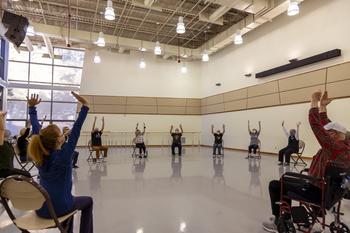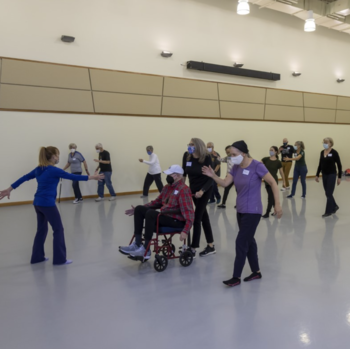
At Mason, the emphasis is on providing students with transformational learning experiences while fostering a positive, collaborative community that promotes well-being and success for all members.
One such program embodying this commitment is Dance for Parkinson's Disease (Dance for PD).
Senior Dance BFA major and Arts Management minor Macie Harris found her involvement in Dance for PD to be an incredible experience.
Dance for PD, a program of Mark Morris Dance Group, operates globally, providing classes for patients and caregivers, as well as training and certification programs to dance professionals. Each session is a movement-based class that gently starts with warm-up movements and progresses to a variety of lively music combinations. This program not only offers physical benefits but also alleviates the social isolation often linked to Parkinson's disease. Students and community members at Mason are welcomed to participate in this joyful program.
Throughout her time at Mason, Macie has seized numerous opportunities that have shaped her future. She has performed works by renowned choreographers such as Doug Varone, Robert Battle, Larry Keigwin, and Camille A. Brown, which provided insight into the professional dance world and allowed her to grow as a dancer and artist. Macie's engagement in the Dance for PD program has revealed another facet of the arts that she intends to explore further after graduation.

The impact of Dance for PD extends beyond physical benefits. For those living with Parkinson's disease, the program's community is a vital source of support. "The Dance for PD community is unlike anything I have experienced," Harris remarks. "In general, those with Parkinson’s disease commonly feel isolated and alone. Many struggle with confidence and feel defeated due to their prognosis. Fortunately, Dance for PD creates a community by bringing together individuals experiencing similar things." Participants in the program at Mason are welcomed into the larger community of the School of Dance as well, spending time on campus not only during their classes, but also attending performances and engaging with students in the school. Mason dance students are encouraged to observe and participate in classes, creating a warm and welcoming environment with a mix of generations in the room.
At George Mason University, programs like Dance for PD emphasize the institution's dedication to cultivating a welcoming, inclusive community focused on its members' well-being. "No matter what, I plan to volunteer and take class as much as possible post-graduation," Harris asserts. "The power of this program shows how dance can move people, ease their stress, provide a community, bring together individuals experiencing similar things, and create joy."
George Mason University's Dance for PD program fosters a healing community through movement, inspiring students like Macie Harris to continue pursuing impactful work in the future.
